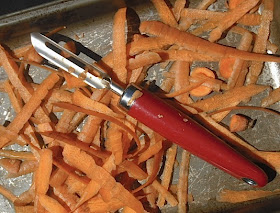There's just something about this carrot cake that makes people sit up to take notice. Perhaps it's the candied ginger or the surprise of the orange, cream-cheese frosting. I don't know. But whenever I make it and give aways slices, I get comments and notes like this one from my neighbor:
Some carrot cakes are loaded with extra ingredients. So much so, carrots take back-stage billing to coconut, pineapple, raisins, nuts, even chocolate! So when I saw this carrot cake from good-ole gal Betty Crocker I was intrigued. And I love crystallized ginger. But I didn't want just a regular cream-cheese frosting. I thought it deserved a bit more oomph--adding a bit of honey and orange did the trick.
This makes a small cake and is one of many on this site that won't feed a wedding party. I love an 8 x 8 cake. It's perfect for a few people. And if you need bigger, simply make another and stack them. For this, I cut one layer in half and frosted it for a small, double layer which I don't recommend since the frosting is very light and needs to be refrigerated. In the future, I may not even frost the cake at all but add a few spoonfuls on the cake as I cut and serve it.
My workmates pronounced it one of the best carrot cakes they've eaten. The cake itself is very moist and redolent with carrots. The ginger is not at all pronounced. But without it, the cake would be a dud. The orange-honey frosting is, of course, wonderful and the perfect companion to such a simple cake, easily served any season of the year.
Avoid buying "jarred" candied ginger in your spice aisle at the grocery store. It's overly expensive. I buy small tubs of it for a few bucks in the organic section of my local store. It lasts forever. I'm not a fan of using all oil in a cake recipe, so I use part butter and part oil. It makes for a moister cake in my opinion without the greasy taste. Grate your own nutmeg--it makes a huge difference. I also use a combo of white and brown sugar for more taste.
- 1 tablespoon AP flour
- 1/4 cup finely chopped crystallized ginger (set aside)
- 1 1/2 cups finely shredded/grated carrots (set aside)
- 1 1/4 cups AP flour
- 1/2 cup granulated white sugar
- 1/4 cup brown sugar, packed
- 1/2 cup melted butter
- 1/4 cup vegetable oil
- 1 1/2 teaspoons ground cinnamon
- 1 teaspoon baking soda
- 1/2 teaspoon salt
- 1/4 teaspoon fresh-grated nutmeg
- 2 teaspoon vanilla
- 2 eggs
Heat oven to 350 F. degrees. Grease an 8 x 8 in square pan. Cut a piece of wax paper or parchment paper to fit in the bottom. Lightly grease it, too.
Using a sharp knife, begin mincing the ginger. It can get sticky, so sprinkle a bit of flour on it as you go.
In a large bowl, mix everything but the shredded carrots and crystallized ginger with an electric mixer on low speed for about one minute or so, just until moistened. Then beat on medium speed for 3 minutes. Now stir in the carrots and ginger. Batter will be thin.
Bake for 30-35 minutes or until a wooden toothpick comes out clean when inserted. Let rest for about ten minutes or so and remove from pan on a wire rack to cook completely before frosting. Cake will be moist and sticky.
Frost cake. Keep refrigerated.
- 4-6 ounces cream cheese
- 2 cups confectioner's sugar
- 1-2 tablespoons honey
- Orange zest of one orange or to taste
Beat all ingredients together until smooth. Add more sugar as needed. Frosting will be light and a bit runny. Feel free to experiment with measurements.













